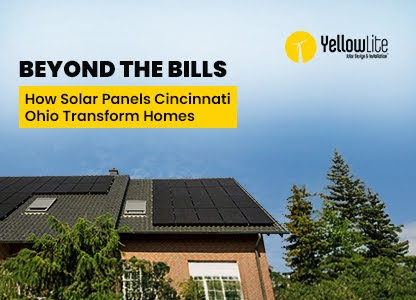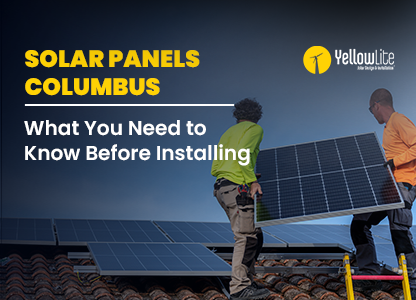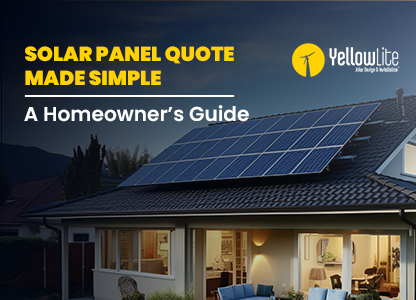Thinking about going solar but unsure about the numbers? You’re not alone. For first-time buyers, solar energy installation cost often feels like a complex equation with too many unknowns. What’s included in the price? Why do quotes vary so much? How do incentives like the 30% federal tax credit actually work?
This guide breaks it all down, integrating all the necessary facts. Whether you’re a homeowner trying to reduce monthly bills or a small business owner looking to lock in long-term savings, we’ll help you understand what solar should really cost, how to get the most value, and how companies like YellowLite make the process transparent and stress-free.
What’s Included in the Solar Energy Installation Cost?
When you get a solar quote, you're not just paying for panels. A solar energy installation cost typically covers:
- Solar Panels – The main hardware capturing sunlight. Tier-1 panels come at a premium but offer higher efficiency and warranties.
- Inverter – Converts solar energy into usable electricity.
- Mounting System – Customized to your roof type (flat, sloped, asphalt, metal, etc.).
- Electrical Wiring and Configuration
- Labor Costs – Design, engineering, and installation team hours.
- Permits and Inspections – Required by local municipalities and utility companies.
- Monitoring System – Many setups include an app or dashboard to track your solar performance.
At YellowLite, every quote you receive already bundles these components- no surprise fees halfway through. That’s a big win for first-time buyers.
What Influences the Final Solar Cost?
Before you compare quotes or commit to a solar provider, it's important to understand what actually shapes your solar energy installation cost. It’s not just about the panels—it’s a combination of technical needs, property characteristics, and incentive eligibility. Here’s a deeper look at the main cost drivers:
1. System Size (in kW) – How Much Power Do You Need?
The size of your solar system is based on how much electricity you use. It’s measured in kilowatts (kW), and the more power you want to generate, the larger the system—and cost.
- A small home might need a 5 kW system.
- A larger home or small business might need 8–10 kW or more.
Typical Costs (Before Incentives):
| System Size | Estimated Solar Cost |
|
5 kW |
$13,750 – $17,500 |
|
10 kW |
$18,500 – $23,000 |
At YellowLite, we help you calculate your ideal system size based on your actual utility bills- so you’re not underpowered or overpaying.
2. Your Roof Type, Angle & Condition – Can Your Roof Support Solar?
Not all roofs are created equal. A complex roof layout or one made from specialty materials (like tile or slate) requires more labor and mounting equipment, which increases the final solar energy installation cost.
Here’s what matters:
- Pitch – Steeper roofs = more labor.
- Material – Asphalt shingles are easier (and cheaper) to install on than tile or metal.
- Condition – If your roof needs repair or replacement soon, it’s smart to handle that before going solar.
Pro tip: YellowLite offers pre-installation roof assessments and will flag any issues before installation day-no surprises later.
3. Energy Usage – How Much Do You Want to Offset?
Your solar system should ideally offset 80–100% of your annual energy use. That means someone with a $150/month electric bill will need a smaller system than a household running EV chargers and pool heaters.
The higher your usage, the larger (and costlier) your system will be. But it also means bigger long-term savings.
Bonus: YellowLite provides an energy usage vs. system size chart in your custom quote, so you can visualize the offset and projected ROI clearly.
4. Location and Sun Exposure – Is Your Roof in the Sun or Shade?
Where you live—and how much sunlight your roof gets—matters more than you think.
- Homes with consistent sunlight throughout the day need fewer panels.
- If trees or other buildings partially shade your roof, your installer might recommend higher-efficiency panels or more panels to make up for it.
Don’t worry, YellowLite uses solar modeling tools to calculate how much power your system can produce based on your actual home.
5. Choice of Equipment – Panels, Inverters, and Warranties
The brand and quality of your solar panels and inverter affect both performance and price. You can opt for:
- Standard Panels – Great balance of cost and performance
- High-Efficiency Panels – More power per square foot, higher price
- Microinverters vs. String Inverters – More flexibility vs. lower cost
With YellowLite, you’ll always see brand options side by side in your quote, along with warranty coverage and efficiency ratings.
6. Local Permits, Inspections & Grid Connection Fees
Every city or county has different permitting costs and inspection fees. Some utilities also charge interconnection fees to connect your solar system to the grid.
YellowLite includes all of these in your quote upfront—because no one likes surprise add-ons after signing a contract.
The 30% Federal Solar Tax Credit : Why Now Is the Time to Act
There’s never been a better time to go solar, and that’s not just a sales pitch.
The Federal Solar Investment Tax Credit (ITC) currently allows you to deduct 30% of your total solar energy installation cost from your federal taxes. That’s thousands of dollars in real savings.
Example:
If your solar system costs $21,000, you get $6,300 back at tax time—bringing your real cost down to $14,700.
⚠️ Urgent Update:
Due to a new House energy bill making its way through Congress, this 30% tax credit may begin phasing out by the end of this year. That means the sooner you start your project, the more you save.
YellowLite stays on top of incentive changes and helps you file everything correctly, so you don’t leave money on the table.
Real-Life Numbers: What Customers Actually Pay
Based on recent customer quotes and installations by YellowLite in Ohio and surrounding states, the average solar cost for residential systems after the 30% federal tax credit falls between $9,500 to $22,000.
For small business owners with larger energy demands, commercial systems (25–50 kW) range from $40,000 to $100,000- again, after incentives.
Sample Residential Invoice – Cleveland, OH
- System Size: 7.2 kW
- Gross Cost: $17,000
- Federal Tax Credit: – $6,696
- Final Cost: $15,624
- Annual Savings: $1,250
- ROI Break-even: 8-10 years
What’s the ROI on Solar?
Most residential systems in Ohio see break-even in 8–12 years, depending on energy usage and local electricity rates. After that, it’s nearly free power for 10–15 more years.
Here’s what affects your solar ROI:
- Electricity Rates – Higher rates = faster ROI
- System Size & Efficiency
- Upfront Cost After Incentives
- Net Metering Credits – You get credits for excess power sent to the grid
At YellowLite, all of this is mapped out in your personalized savings report—so you know exactly what to expect, before you sign.
Transparent Pricing with YellowLite
First-time solar buyers deserve clear answers. That’s why YellowLite offers itemized, no-pressure quotes with:
✅ Transparent cost per watt ✅ Breakdown of all included components
✅ Incentive calculations upfront
✅ Financing options with no hidden fees
✅ Dedicated solar consultant, not a call center rep

Final Thoughts: Solar Isn’t Just Affordable. It’s Smart.
Navigating your first solar energy installation cost quote doesn’t have to feel overwhelming. With the right installer and a clear breakdown of what you’re paying for, solar becomes a smart, strategic investment, not just a home improvement.
And with YellowLite, you’re not just buying panels, you’re gaining a trusted partner committed to helping you switch with confidence.
FAQs
1. What’s the average solar energy installation cost in 2025?
For homeowners, the solar energy installation cost is approximately $15,000–$25,000 before incentives and $10,000–$17,500 after applying the 30% federal tax credit. This average varies based on your location and system size.
2. Why do solar cost estimates vary so much?
Because solar cost depends on several factors: system size, roof complexity, energy usage, panel quality, and installer experience. That’s why YellowLite provides detailed, line-item quotes for clarity.
3. Can I finance my solar energy installation cost?
Yes! Many homeowners choose $0 down financing options to cover their solar energy installation cost. Through YellowLite’s financing partners, your payments can be structured similarly to your current electric bill.
4. How long until solar pays for itself?
Most homeowners see a return on their solar energy installation cost within 5–12 years, depending on how much electricity they offset and the local utility rates.
5. Are there any hidden solar cost elements I should watch out for?
Absolutely. Some providers may exclude permit fees, design costs, or hardware upgrades, which add unexpected solar cost later. YellowLite ensures that everything is included upfront—what you see is what you pay.
6. What’s the cost per watt for solar in 2025?
The average solar cost per watt ranges from $2.75 to $3.50, depending on location and equipment. This metric helps estimate your solar energy installation cost quickly based on system size.
7. Do solar prices differ between homes and small businesses?
Yes—while solar cost for commercial systems is higher in total, the cost per watt is often lower due to system scale. YellowLite specializes in both residential and commercial solutions, offering tailored pricing.
8. How does my roof type affect solar cost?
If your roof is sloped, tiled, or in poor condition, your total solar energy installation cost may increase due to the need for extra labor and mounting equipment.
9.Can I reduce my solar cost by choosing lower-end panels?
You can reduce upfront solar cost, but it may come at the expense of efficiency, warranty, and long-term savings. YellowLite helps you strike the right balance between cost and quality.
10. Will my solar installation cost more if I add a battery?
Yes, battery storage can add $9,000–$15,000 to your solar energy installation cost, depending on the capacity and brand.
11. What happens if incentives change after I sign the contract ?
If you sign in 2025, you’ll likely still qualify for the 30% federal tax credit, but due to a proposed House energy bill, this incentive could phase out soon. Locking in your solar energy installation cost now ensures you maximize savings.



